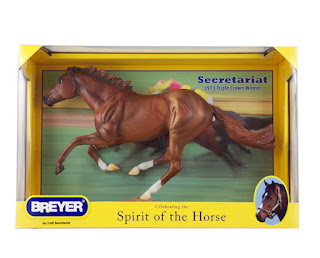Our conversations reminded me of these drawings by C.W. Anderson from his book Blaze and the Spotted Pony. How well he knew us!
So I decided to go into the venerable Newspapers.com database and dig around for expressions such as "model horse," "horse figurine," and "horse collection" in the context that we in the hobby think of those terms.
While most people in the hobby today are women and girls, boys played a significant part of the newspaper stories I read about horse collections. The earliest example of the phrase "horse collection" I could find (not referring to someone with a lot of real horses) came from the Pittsburgh Press newspaper, January 25, 1937. A young man, James W. Arrott, IV, entered his miniature horse collection in a local hobby show.
An Abilene (Texas) Reporter newspaper story from October 13, 1938, described Mrs. W.D. Fagan's "unusual" miniature horse collection that ranged from half an inch to about a foot high. The paper had asked its readers to tell them about their hobbies.
The earliest newspaper stories I read didn't discuss groups of collectors buying, selling, trading model horses amongst themselves, or corresponding about their hobby. It appeared that lots of Americans had collections of figurines, and some of them collected horses. Children who had collections often met at a club such as a 4H or riding club, a Scout troop, or a library, and perhaps shared their common interest there.
The Greeley (Colorado) Daily Tribune reported on June 24, 1944, that local school children raised money for a $100 War Bond by charging admission to see their collections of various items, including lambs, pigs, and horses.
Merchants caught on to the need to advertise horse collectibles, as shown in the Salem (Oregon) Capital Journal ad for the Metropolitan store from April 12, 1945:
By the 1940s, collectors putting model horse collections on display in local public libraries seemed to be fairly common. This may have been due, in part, to the increasing popularity of juvenile fiction horse books. Walter Farley's The Black Stallion was first published in 1941; The Black Stallion Returns came out in 1945, the same year Marguerite Henry's Justin Morgan Had a Horse was published.
The Mount Pleasant (Iowa) News, March 18, 1946, describes such a display.
So where did people find model horses, before the days of Breyer, Hartland, and Hagen-Renaker? Their options were limited, including toys, handmade horses (ceramic or hand-carved), or ceramic and metal horse figurines marketed as decorative objects. A search for the phrase "horse figurine" turned up this ad from the Amarillo Globe-Times, December 8, 1938:
Later, ads and articles aimed specifically at people who had animal collections became more numerous. The Dayton Daily News, August 26, 1945, had a hobby-specific advertisement for Wagner's:
Fred Meyer Drugs advertised one of its early horse figurines in the November 13, 1945 Salem Capital Journal:
Graceful Horse Figurines appear in this November 22, 1945 ad for Sears, Roebuck & Co. in the Minneapolis Star:
In 1946, the name of a pioneering model horse designer began to appear in Idaho newspapers as well as in magazines such as Western Horseman: Virginia Orison. (She deserves a separate blog post, which I'm working on.)
Metal horse figurines were common in American households, gracing bookshelves and fireplace mantels. And by the late 1940s, kids and adults from all walks of life were given model horses as gifts. President Harry Truman, for example, in 1948, received what looks a lot like a small metal horse in Western tack like the one that Gladys Brown Edwards designed. The horse was sent to the president as a birthday gift from a nine-year-old Wyoming boy.
By 1954, newspaper ads had begun to show illustrations of horse-shaped objects we might recognize. The Ben Franklin stores ran this ad in newspapers in July 1954:
In the 1950s it was common to see boys and girls with model horse collections mentioned in their local newspapers. This photo from the November 28, 1957 Nashville Tennessean shows a group of girls admiring what may have been a Beswick 976 mare in bay.
The Winona, Minnesota Daily News, November 29, 1958, showed a photo of collectors with (among others) some new-at-the-time Hagen-Renaker horse figurines, as well as what might be one of the Orison Quarter Horse models under Western tack.
In the near future I'll post some other examples of reporting on model horse collections before 1960, using old horse magazines as my sources. Stay tuned!




























